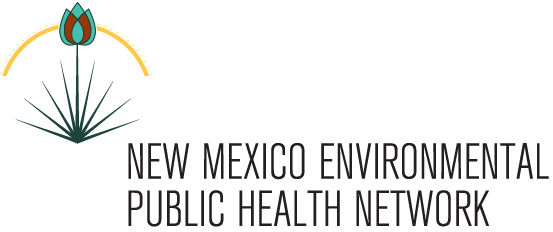Feb 27, 2020 –
We’re excited to launch into 2020 with a few fresh updates, including a newsletter to keep you informed about our state’s environmental health.
In addition to our newsletter update, as you can see we have recently updated our website to provide easier access to information and updates both nationally and state-wide.
NEWS
2019 NMEPHN Conference Features Nationally Known Expert Dr. Ruth Etzel

The New Mexico Environmental Public Health Network wrapped up 2019 with its annual meeting featuring keynote speaker, Dr. Ruth Etzel, George Washington University professor and nationally known expert in children’s environmental health issues.
Dr. Etzel reported that more than 1.7 million deaths of children worldwide each year can be directly attributed to environmental impacts at least one-quarter of these could be prevented with basic changes to the environment. She spoke about the increasing numbers of some childhood diseases, including childhood asthma, brain cancer, autism and lymphocytic leukemia that can be tied to a variety of factors including environmental impacts. Etzel stressed that due to a variety of factors, children are much more vulnerable than adults to environmental contaminants and the effects of these contaminants can often be delayed for months and even years.
Etzel also spoke to the audience about a landmark case in children’s environmental health in New Mexico in the late 1960s involving mercury poisoning of the Hucklebee family. See the New York Times article for more information. Also featured on NYT, E.P.A. Places the Head of Its Office of Children’s Health on Leave.
Also joining the Network for the day were New Mexico Environment Department Deputy Cabinet Secretary Jennifer Pruett and New Mexico Department of Health Environmental Health Bureau Chief Srinkanth Paladugu who spoke to the audience about their department’s environmental health policy priorities including methane regulations and clean transportation regulations.
Thank you to all of you who joined us for this important event.
The Connection Between Wildfires and Human Health
The recent wildfires in Australia have once again shown how climate change is having profound impacts on human health. Though wildfires are a natural part of ecosystems, contributing to forest health and the natural recovery of many species of plants, scientists now know that climate change is directly tied to the increase in the number of fires, and the increased duration and severity of fires.
Not only can wildfires have devastating impacts on human life, property, and nature, but people living in wildfire-prone areas and people living thousands of miles from the actual fire can experience significant health impacts. In recent years, many New Mexico communities have experienced health risks from fires in New Mexico, and neighboring states such as Colorado, California, and Arizona.
It should be noted that about half of all wildfires in New Mexico are caused by abandoned campfires and other careless behavior by humans. The Forest Service is understaffed and the message is not reaching campers, hunters, and others. It is essential that the public is educated about this issue and that the Forest Service prohibits open fires in times of high fire risk.
2019 was a better year for wildfires in general, but each year brings about increased risks. From January 1 to November 22, 2019, there were 46,706 wildfires, compared with 52,080 wildfires in the same period in 2018, according to the National Interagency Fire Center (NIFC). About 4.6 million acres were burned in the 2019 period, compared with 8.5 million acres in 2018.
The Forest Service conducts controlled burns and thinning activities in many parts of the state. The Rio Grande Water Fund has brought together a number of jurisdictions with the goal of reducing damage from wildfires. There are questions about the efficacy of thinning and burning which need to be addressed in specific locations. Taking measures to reduce risks in the interface between wildlands and human developments is the most important step. Learn more about the Rio Grande Water Fund.
The composition of wildfire smoke is primarily made of carbon dioxide, water vapor, carbon monoxide, particulate matter, hydrocarbons and other organic chemicals, nitrogen oxides, and many other trace elements. Of these pollutants, particulate matter (PM) is the most concerning, given their very small size and ability to be inhaled deeply into the lungs. According to the U.S. Climate Health Alliance, exposure to PM generated from wildfires has been associated with a wide range of human health effects, such as wheezing, coughing, sore eyes and throats, and shortness of breath, to more adverse health outcomes, ranging from increases in asthma-related hospitalizations, chronic and acute respiratory and cardiovascular health outcomes, and premature death. Children and the elderly are some of the populations most vulnerable to wildfire smoke.
The New Mexico Environment Department issues warnings when smoke from wildlife is putting New Mexicans at risk. See https://www.env.nm.gov/air-quality/wildland-fires/ The U.S. Environmental Protection Agency Smoke Ready Toolbox also offers a variety of resources for health professionals and community members to identify ways the public can prepare to reduce their health risk before a wildfire and help educate people about the risks of smoke exposure and actions they can take to protect their health. View toolbox.
Learn About the Importance of Healthy Soil through the New Mexico Healthy Soil Working Group
Healthy land, especially soil, is a critical component of environmental public health. Not only does healthy soil play an important role in absorbing carbon emissions, but it sustains the food we eat and serves as a filtering mechanism for pollutants.
Some of the environmental stresses impacting New Mexico’s land include gas and oil extraction, use of pesticides and fertilizers, overgrazing and over-cultivation, and other activities that cause the degradation of soils. These stresses have impacts on human health including respiratory diseases from atmospheric dust, water, and food-borne diseases and reduced food supplies.
Recognizing the importance of this public health issue, a NM Healthy Soil Working Group formed in the fall of 2018, with the goal to significantly accelerate soil health stewardship in the state. The group succeeded in passing the New Mexico Healthy Soil Act to address some of New Mexico’s challenges including inadequate soil health education, lack of financial incentives and prevailing institutional barriers.
The Healthy Soil Act is based on 5 proven soil health principles and establishes a voluntary incentives program and robust support system including access to soil health testing, education and training opportunities, as well as financial and technical assistance. Program participants learn about soil health in on-site, producer-led workshops and receive technical assistance to put these ideas into practice. The Department of Agriculture is tasked with executing the act, including a comprehensive soil health education package and user-friendly grant program, which was launched in August 2019.
For more information on educational and funding opportunities related to healthy soil, please visit NM Healthy Soil.




